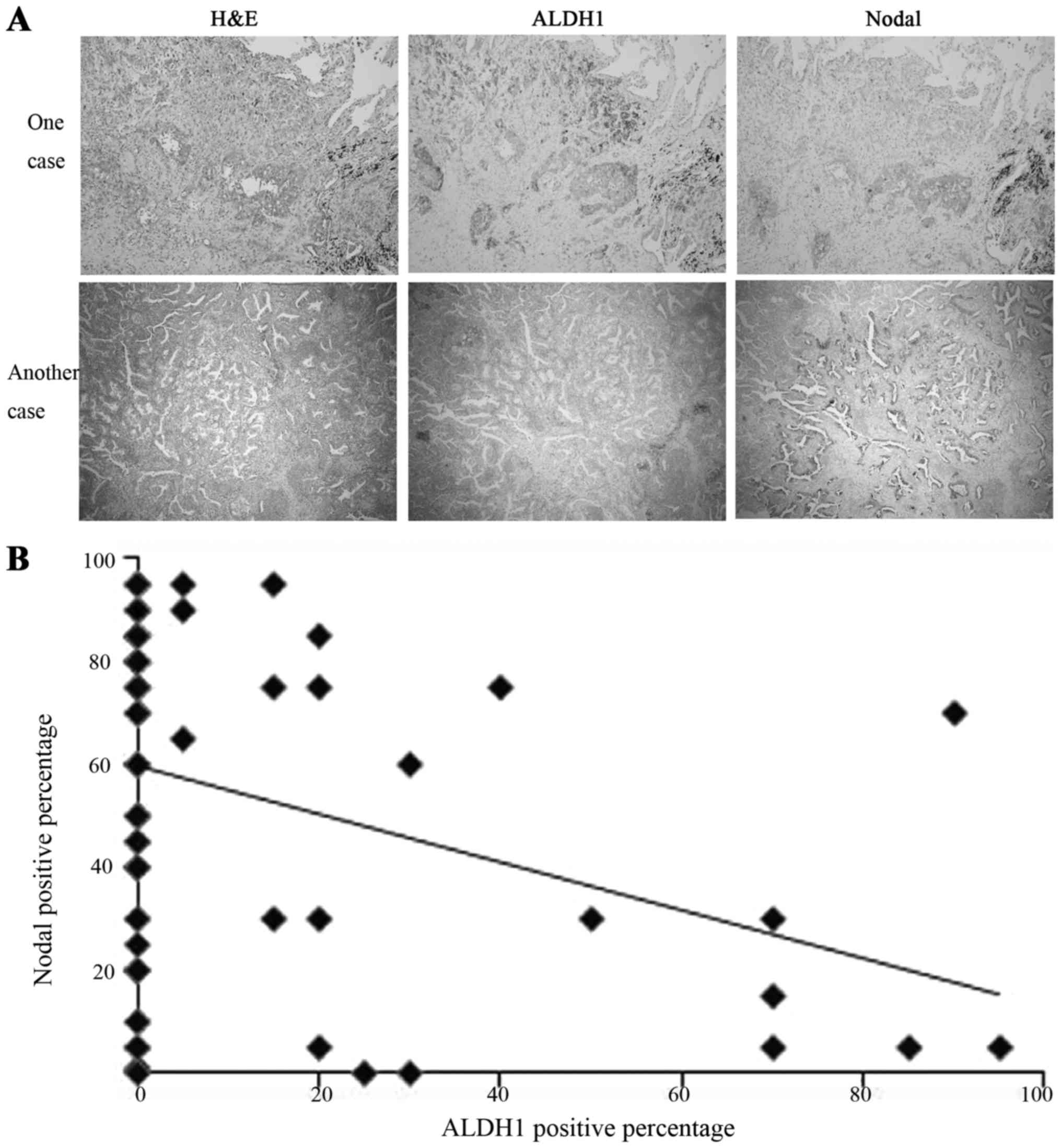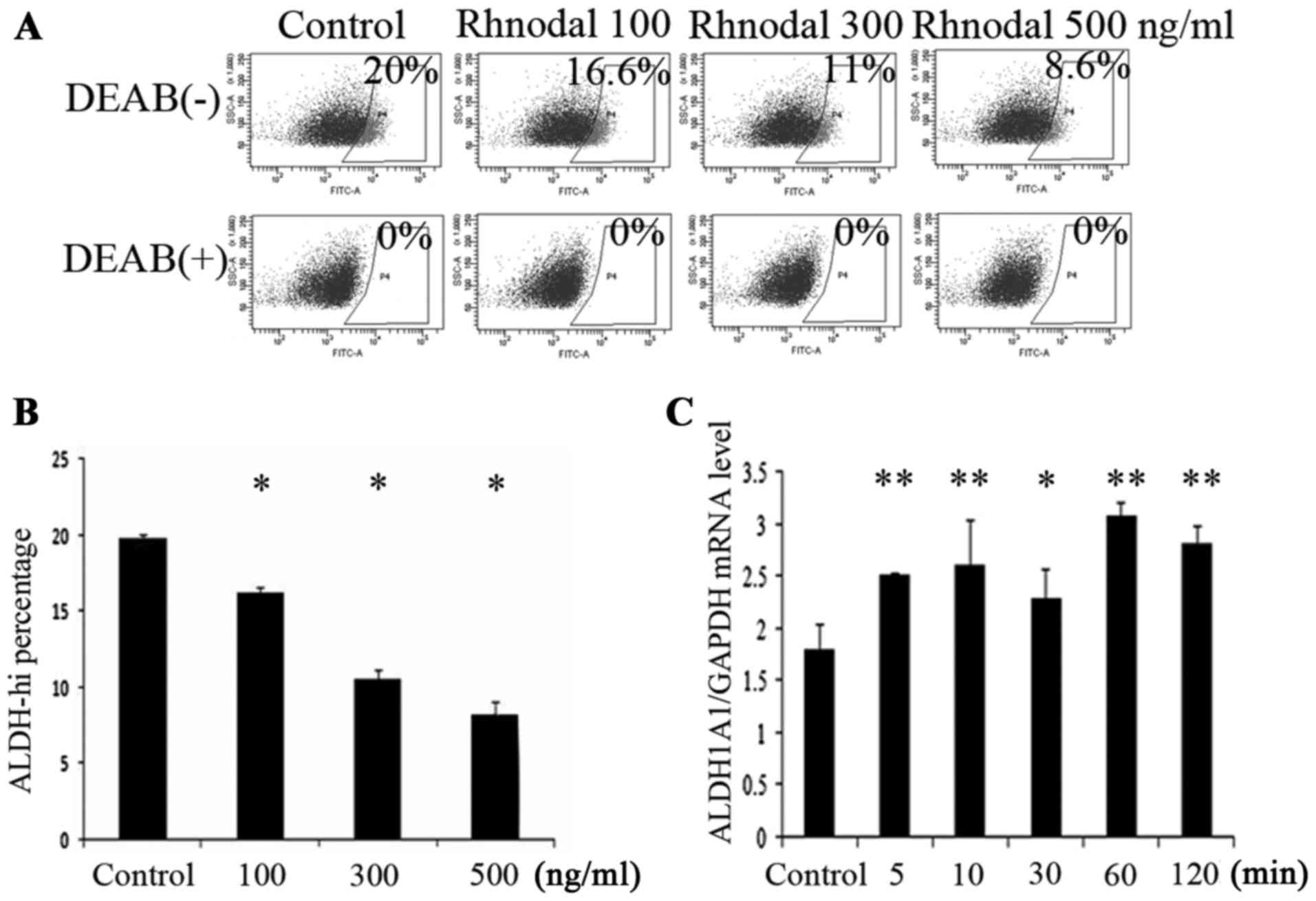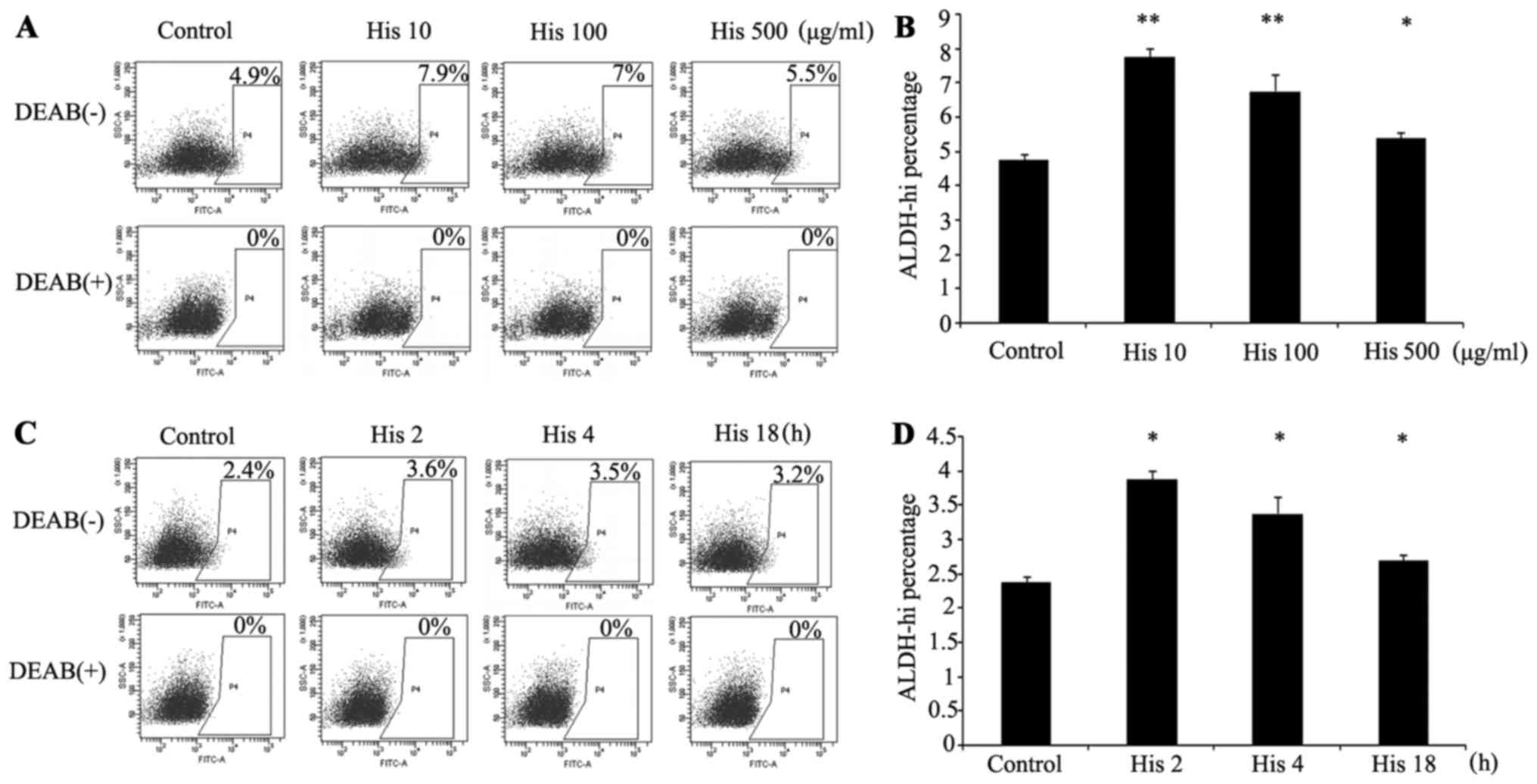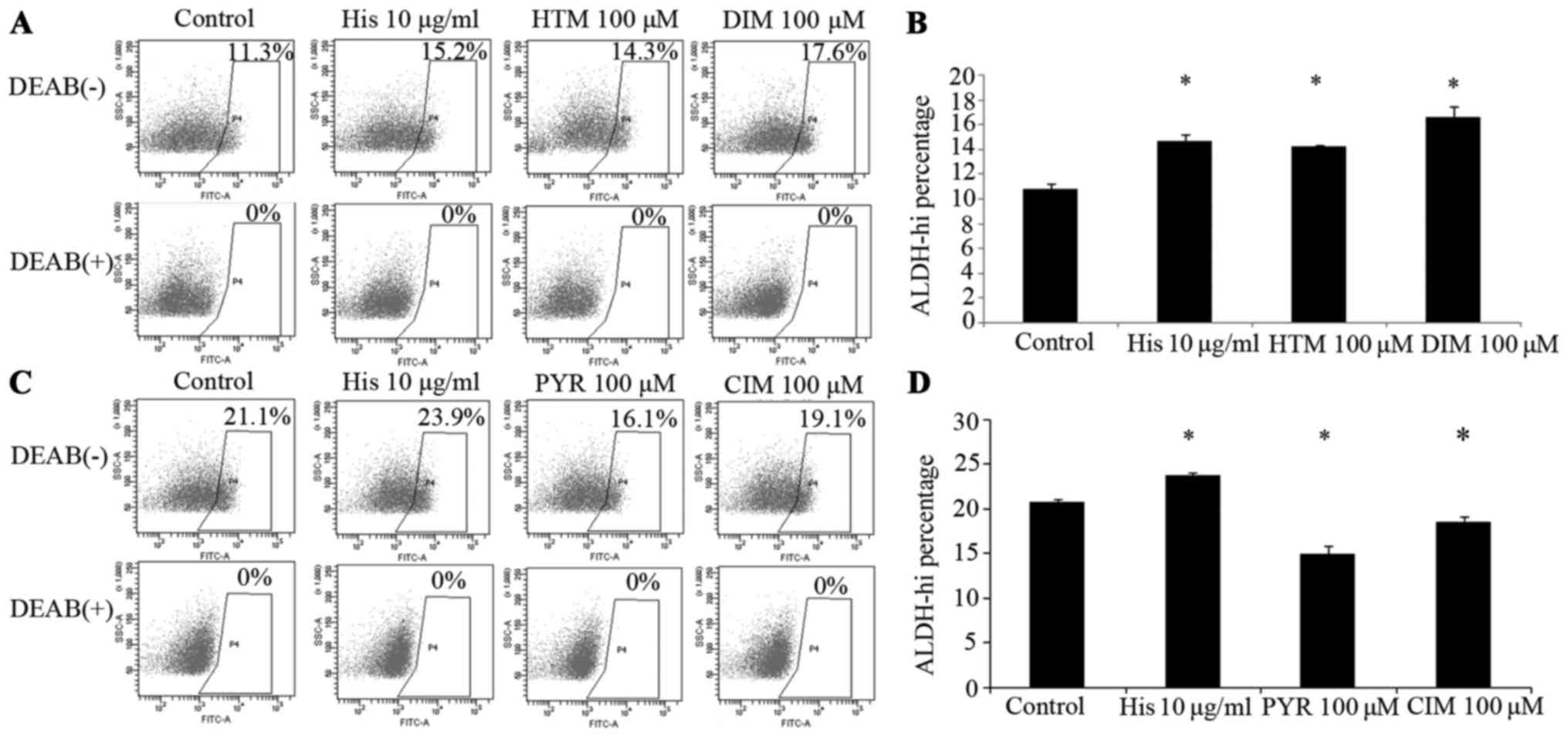|
1
|
Parkin DM, Bray F, Ferlay J and Pisani P:
Global cancer statistics, 2002. CA Cancer J Clin. 55:74–108. 2005.
View Article : Google Scholar : PubMed/NCBI
|
|
2
|
Egevad L, Heanue M, Berney D, Fleming K
and Ferlay J: Histological groupsCancer Incidence in Five
Continents. IX. Curado MP, Edwards B, Shin HR, Storm H, Ferlay J,
Heanue M and Boyle P: IARC Scientific Publications; Lyon: pp.
62–64. 2007
|
|
3
|
Marcato P, Dean CA, Giacomantonio CA and
Lee PW: Aldehyde dehydrogenase: Its role as a cancer stem cell
marker comes down to the specific isoform. Cell Cycle.
10:1378–1384. 2011. View Article : Google Scholar : PubMed/NCBI
|
|
4
|
Al-Hajj M, Wicha MS, Benito-Hernandez A,
Morrison SJ and Clarke MF: Prospective identification of
tumorigenic breast cancer cells. Pro Natl Acad Sci USA.
100:3983–3988. 2003. View Article : Google Scholar
|
|
5
|
Ginestier C, Hur MH, Charafe-Jauffret E,
Monville F, Dutcher J, Brown M, Jacquemier J, Viens P, Kleer CG,
Liu S, et al: ALDH1 is a marker of normal and malignant human
mammary stem cells and a predictor of poor clinical outcome. Cell
Stem Cell. 1:555–567. 2007. View Article : Google Scholar : PubMed/NCBI
|
|
6
|
Marchitti SA, Brocker C, Stagos D and
Vasiliou V: Non-P450 aldehyde oxidizing enzymes: The aldehyde
dehydrogenase superfamily. Expert Opin Drug Metab Toxicol.
4:697–720. 2008. View Article : Google Scholar : PubMed/NCBI
|
|
7
|
Black W and Vasiliou V: The aldehyde
dehydrogenase gene superfamily resource center. Hum Genomics.
4:136–142. 2009. View Article : Google Scholar : PubMed/NCBI
|
|
8
|
Travis WD, Brambilla E, Noguchi M,
Nicholson AG, Geisinger KR, Yatabe Y, Beer DG, Powell CA, Riely GJ,
Van Schil PE, et al: International association for the study of
lung cancer/American thoracic society/European respiratory society
international multidisciplinary classification of lung
adenocarcinoma. J Thorac Oncol. 6:244–285. 2011. View Article : Google Scholar : PubMed/NCBI
|
|
9
|
Huang EH, Hynes MJ, Zhang T, Ginestier C,
Dontu G, Appelman H, Fields JZ, Wicha MS and Boman BM: Aldehyde
dehydrogenase 1 is a marker for normal and malignant human colonic
stem cell (SC) and tracks SC overpopulation during colon
tumorgenesis. Cancer Res. 69:3382–3389. 2009. View Article : Google Scholar : PubMed/NCBI
|
|
10
|
Fujimoto S, Komine M, Karakawa M, Uratsuji
H, Kagami S, Tada Y, Saeki H, Ohtsuki M and Tamaki K: Histamine
differentially regulates the production of Th1 and Th2 chemokinesby
keratinocytes through histamine H1 receptor. Cytokine. 54:191–199.
2011. View Article : Google Scholar : PubMed/NCBI
|
|
11
|
Livak KJ and Schmittgen TD: Analysis of
relative gene expression data using real-time quantitative PCR and
the 2(-Delta Delta C(T)) method. Methods. 25:402–408. 2001.
View Article : Google Scholar : PubMed/NCBI
|
|
12
|
Strizzi L, Postovit LM, Margaryan NV,
Lipavsky A, Gadiot J, Blank C, Seftor RE, Seftor EA and Hendrix MJ:
Nodal as a biomarker for melanoma progression and a new therapeutic
target for clinical intervention. Expert Rev Dermatol. 4:67–78.
2009. View Article : Google Scholar : PubMed/NCBI
|
|
13
|
James D, Levine AJ, Besser D and
Hemmati-Brivanlou A: TGFbeta/activin/nodal signaling is necessary
for the maintenance of pluripotency in human embryonic stem cells.
Development. 132:1273–1282. 2005. View Article : Google Scholar : PubMed/NCBI
|
|
14
|
Vallier L, Reynolds D and Pedersen RA:
Nodal inhibits differentiation of human embryonic stem cell salong
the neuroectodermal default pathway. Dev Biol. 275:403–421. 2004.
View Article : Google Scholar : PubMed/NCBI
|
|
15
|
Massagué J, Seoane J and Wotton D: Smad
transcription factors. Genes Dev. 19:2783–2810. 2005. View Article : Google Scholar : PubMed/NCBI
|
|
16
|
Schier AF: Nodal morphogens. Cold Spring
Harb Perspect Biol. 1:a0034592009. View Article : Google Scholar : PubMed/NCBI
|
|
17
|
Katsuno Y, Ehata S, Yashiro M, Yanagihara
K, Hirakawa K and Miyazono K: Coordinated expression of REG4 and
aldehyde dehydrogenase 1 regulating tumourigenic capacity of
diffuse-type gastric carcinoma-initiating cells is inhibited by
TGF-β. J Pathol. 228:391–404. 2012. View Article : Google Scholar : PubMed/NCBI
|
|
18
|
Leurs R, Bakker RA, Timmerman H and de
Esch IJ: The histamine H3 receptor: From gene cloning to H3
receptor drugs. Nat Rev Drug Discov. 4:107–120. 2005. View Article : Google Scholar : PubMed/NCBI
|
|
19
|
Seifert R, Strasser A, Schneider EH,
Neumann D, Dove S and Buschauer A: Molecular and cellular analysis
of human histamine receptor subtypes. Trends Pharmacol Sci.
34:33–58. 2013. View Article : Google Scholar : PubMed/NCBI
|
|
20
|
Akdis CA and Blaser K: Histamine in the
immune regulation of allergic inflammation. J Allergy Clin Immunol.
112:15–22. 2003. View Article : Google Scholar : PubMed/NCBI
|
|
21
|
Falus A, Pós Z and Darvas Z: Histamine in
normal and malignant cell proliferation. Adv Exp Med Biol.
709:109–123. 2010. View Article : Google Scholar : PubMed/NCBI
|
|
22
|
Hill SJ, Ganellin CR, Timmerman H,
Schwartz JC, Shankley NP, Young JM, Schunack W, Levi R and Haas HL:
International Union of Pharmacology. XIII. Classification of
histamine receptors. Pharmacol Rev. 49:253–278. 1997.PubMed/NCBI
|
|
23
|
Robinson AJ and Dickenson JM: Activation
of the p38 and p42/p44 mitogen-activated protein kinase families by
the histamine H(1) receptor in DDT(1)MF-2 cells. Br J Pharmacol.
133:1378–1386. 2001. View Article : Google Scholar : PubMed/NCBI
|
|
24
|
Bakker RA, Schoonus SB, Smit MJ, Timmerman
H and Leurs R: Histamine H(1)-receptor activation of nuclear
factor-kappa B: Roles for G beta gamma- and G alpha(q/11)-subunits
in constitutive and agonist-mediated signaling. Mol Pharmacol.
60:1133–1142. 2001.PubMed/NCBI
|
|
25
|
Muzio G, Trombetta A, Maggiora M,
Martinasso G, Vasiliou V, Lassen N and Canuto RA: Arachidonic acid
suppresses growth of human lung tumor A549 cellsthrough
down-regulation of ALDH3A1 expression. Free Radic Biol Med.
40:1929–1938. 2006. View Article : Google Scholar : PubMed/NCBI
|














